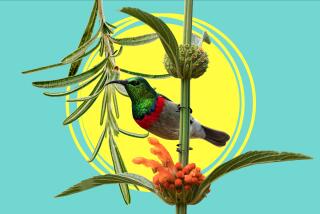Gardening
- Share via
Thymus vulgaris
Common thyme
Perennial herb with small, aromatic leaves
Despite all the attention lavished on basil in recent years, thyme is still one of the most popular kitchen herbs, essential in French cuisine.
An herb publication once advised: “When in doubt, use thyme.” It enhances without overwhelming, the leaves are so small they don’t need to be chopped, and, most important, dried thyme leaves are as pungent as the fresh ones. Dried basil is pathetic.
Thyme is also a terrific plant for Southern California; it prefers lots of sun; poor, sandy soil and little irrigation, except for desert areas (thyme should be watered at ground level; wet leaves lose their fragrance). In most parts of Los Angeles, thyme is a constant, never dying. Like another Mediterranean herb, rosemary, thyme is virtually carefree.
Unlike rosemary, thyme isn’t much of a landscape plant. It stays low, about 12 inches, and spreads about 18 to 24 inches. Because of this compact size, thyme is comfortable in containers.
In summer, tiny lilac-colored flowers almost cover the plants; for drying, cut the stems just before or during flowering. Hang the stems upside down in the shade, and when they are completely dried, strip off the leaves and flowers and keep in an airtight container. The leaves are so tiny and so far apart on the stems that they will probably yield a smaller batch than expected.
Although thyme is best known as a culinary herb, it has other uses. The Egyptians used it for embalming--and it’s still an ingredient in that process; the Scots drank thyme tea to prevent nightmares; to the ancient Romans, thyme meant courage, and soldiers bathed in thyme water to strengthen themselves before battle.
Common thyme can be propagated from stem cuttings, best done in spring, and it grows easily from seed, but many of the unusual thymes (caraway, coconut, lemon, among others) can’t be grown from seed. Thymus vulgaris seeds are tiny, so they should be covered with only the barest amount of planting medium and kept moist (but not wet) until they’re large enough to plant into the garden. If thyme seeds are not carried by a local nursery, any seed catalogue with an herb section will have them.
Likewise, almost any nursery with an herb section will carry thyme plants. Finding (and growing) this plant is no challenge--but it is deliciously rewarding nonetheless.






